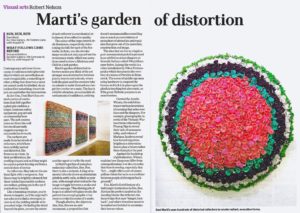Marti’s garden of distortion
 Contemporary art loves the uncanny; it cultivates indecipherable objects which are nevertheless almost recognisable, a something or other, a thing that deserves a name yet cannot easily be labelled. As an unidentified something, the art object can symbolise the unconscious. At Arc One, Dani Marti has created a series of confections that fold together a giant pin-cushion, a target, luminous safety equipment, pop art and an ornamental bouquet. The soft centres come out from the wall but simultaneously suggest a spongy accommodation to touch. The surfaces are made from hundreds of reflectors, which have been artfully melted and distorted, like flounces on a hem. In their proliferation, the swelling shapes look as if they might be copious petals fanning out from a central stem of nectar. As reflectors, they take on the ambient light with a vengeance. Any bloom may be brightly coloured; but these twisted inscrutable surfaces are radiant, poking you in the eye if you look too intently to try to discover their substance. Like a humming creature, you’re drawn to inquire, as if the large bull’s eye asks you to find a sweet spot, to zero in on the yielding middle at its proudest bulge. On finding the detail beyond the glare, you see that the centre of each reflector is a mechanical attachment of no reflective quality. The colour of the large central circle dominates, respectively determining the title for each work. In the gallery, five are displayed, suggesting the spectral completeness of a painter’s palette. In form, too, the circular shape recalls not only pop art but the renaissance tondo, which was sometimes used to show a Madonna and Child in a lush garden. Marti’s garden of distorted reflectors makes you think of the yet stranger sexual attraction between plants, insects and animals, where both the plant and the creature take on colours to make themselves a target for a vector or a mate. The hue is a bid for attention, an outlandish advertisement of confidence, an offer in nature’s bright language, which entices another agent to traffic the seed. In Marti’s garden of metaphor, ominously called Run, Run, Run, there is also a serpent. A long ornamental tube sits above an aluminium plinth in awful coils, as thick as your arm, with enough abstraction for the image to toggle between a snake and a door sausage. This slinking pile of loops is studded with glass beads; the pattern has enough graphic criss-cross to evoke the scales of a snake. Though allusive, the objects in Run, Run, Run are an anti-monument, a proposition that doesn’t monumentalise something else so much as convolutions of metaphors of attraction and repulsion that grow out of the materials, construction and image. robert.nelson@monash.edu Download review by Robert Nelson
Contemporary art loves the uncanny; it cultivates indecipherable objects which are nevertheless almost recognisable, a something or other, a thing that deserves a name yet cannot easily be labelled. As an unidentified something, the art object can symbolise the unconscious. At Arc One, Dani Marti has created a series of confections that fold together a giant pin-cushion, a target, luminous safety equipment, pop art and an ornamental bouquet. The soft centres come out from the wall but simultaneously suggest a spongy accommodation to touch. The surfaces are made from hundreds of reflectors, which have been artfully melted and distorted, like flounces on a hem. In their proliferation, the swelling shapes look as if they might be copious petals fanning out from a central stem of nectar. As reflectors, they take on the ambient light with a vengeance. Any bloom may be brightly coloured; but these twisted inscrutable surfaces are radiant, poking you in the eye if you look too intently to try to discover their substance. Like a humming creature, you’re drawn to inquire, as if the large bull’s eye asks you to find a sweet spot, to zero in on the yielding middle at its proudest bulge. On finding the detail beyond the glare, you see that the centre of each reflector is a mechanical attachment of no reflective quality. The colour of the large central circle dominates, respectively determining the title for each work. In the gallery, five are displayed, suggesting the spectral completeness of a painter’s palette. In form, too, the circular shape recalls not only pop art but the renaissance tondo, which was sometimes used to show a Madonna and Child in a lush garden. Marti’s garden of distorted reflectors makes you think of the yet stranger sexual attraction between plants, insects and animals, where both the plant and the creature take on colours to make themselves a target for a vector or a mate. The hue is a bid for attention, an outlandish advertisement of confidence, an offer in nature’s bright language, which entices another agent to traffic the seed. In Marti’s garden of metaphor, ominously called Run, Run, Run, there is also a serpent. A long ornamental tube sits above an aluminium plinth in awful coils, as thick as your arm, with enough abstraction for the image to toggle between a snake and a door sausage. This slinking pile of loops is studded with glass beads; the pattern has enough graphic criss-cross to evoke the scales of a snake. Though allusive, the objects in Run, Run, Run are an anti-monument, a proposition that doesn’t monumentalise something else so much as convolutions of metaphors of attraction and repulsion that grow out of the materials, construction and image. robert.nelson@monash.edu Download review by Robert Nelson